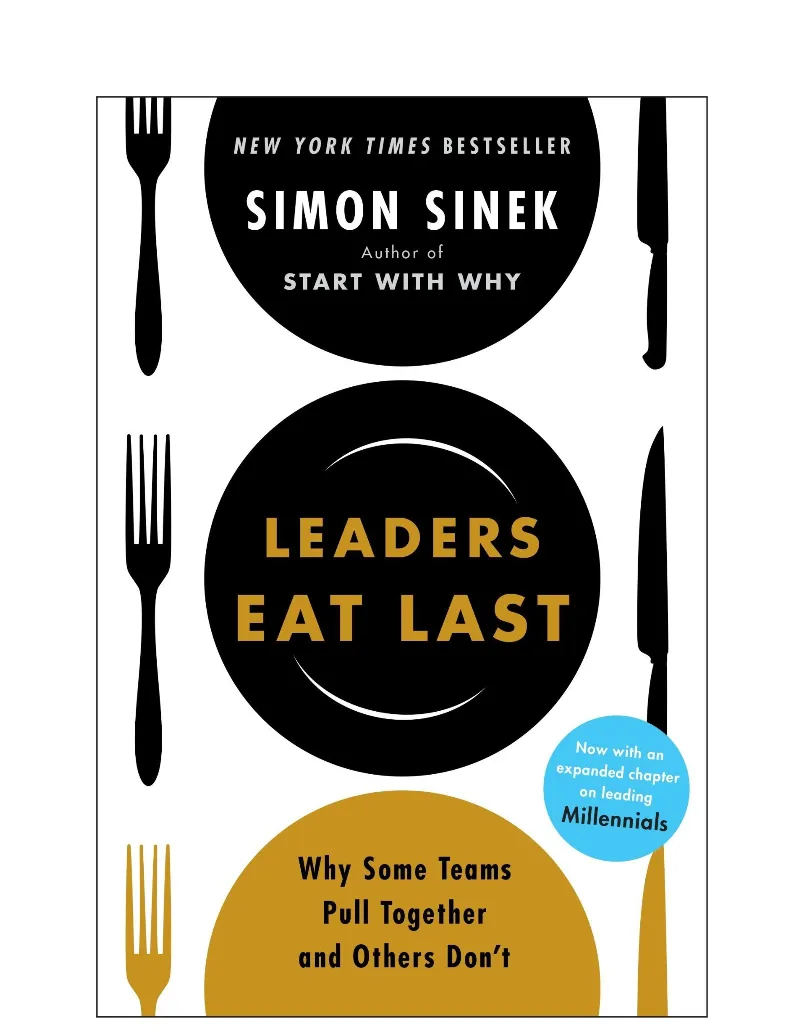
Book Summary Leaders Eat Last by Simon Sinektled document
True leadership is not about titles, it is about creating a culture where people feel safe, valued, and inspired to give their best. Simon Sinek’s Leaders Eat Last uncovers the biology of trust, teamwork, and sacrifice, showing why great leaders build environments where teams thrive together.
Summary of Leaders Eat Last by Simon Sinek
In Leaders Eat Last, Simon Sinek explores why some organizations foster cooperation, innovation, and loyalty, while others breed fear, competition, and burnout. He argues that leadership is not a position but a responsibility: to create a “Circle of Safety” where people feel secure enough to collaborate, innovate, and commit fully. Drawing on biology, history, and modern workplace examples, Sinek explains how hormones shape our behavior and why leaders who put their people first inspire trust and long-term success. The book reminds us that in uncertain, fast-changing environments, human connection and trust remain the strongest competitive advantages.
Key Takeaways
The Circle of Safety
The core of leadership is creating an environment where employees feel safe from internal threats (layoffs, politics, rivalries) so they can focus on external challenges (customers, competitors, markets).
When safety is absent, individuals focus on self-preservation rather than team success.
Biology of Leadership: The Four Chemicals
Endorphins – Mask pain and push us through stress (like during exercise).
Dopamine – Drives achievement, rewarding us for hitting goals.
Serotonin – Reinforces trust, pride, and recognition, strengthening social bonds.
Oxytocin – The “love hormone,” released through trust, empathy, and human connection.
Sinek argues that effective leadership balances dopamine (short-term rewards) with serotonin and oxytocin (long-term bonds), while minimizing cortisol (the stress hormone).
Leaders Sacrifice First
Borrowing from the military practice where officers eat last, true leaders prioritize the needs of their team above personal comfort or gain.
This sacrifice builds trust and loyalty, ensuring people reciprocate when challenges arise.
Trust and Empathy are Non-Negotiable
Trust is built when leaders demonstrate empathy, listen actively, and protect their people from harm.
Organizations where trust is absent see disengagement, turnover, and toxic politics.
Short-Term vs. Long-Term Leadership
Companies obsessed with quarterly results often erode trust, cut corners, and treat employees as expendable.
Sustainable success comes from leaders who prioritize people and culture over quick wins. Costco and Southwest Airlines are examples of organizations that thrive by investing in their people.
Danger of Abstraction
Sinek warns that treating people as numbers or data points (abstraction) disconnects leaders from reality. For example, layoffs may look logical on spreadsheets but devastate lives, weakening long-term loyalty and trust.
The Leadership-Trust Feedback Loop
When leaders protect and empower people, employees respond with loyalty and discretionary effort.
Over time, this cycle of mutual trust builds resilience, innovation, and strong performance.
Leadership is Human, Not Technical
Great leadership is about human behavior, not efficiency charts or management tools. It thrives on listening, caring, and creating meaning.
Culture is the Ultimate Differentiator
In a competitive, fast-changing world, technology and strategies can be copied, but a culture of trust and safety cannot.
Key Action Items
Create a Circle of Safety
Actively shield employees from unnecessary internal threats, politics, and fear. Focus them on solving external challenges instead.
Establish transparent communication so people know where they stand.
Lead by Example
Demonstrate sacrifice by taking responsibility during failures and giving credit during successes.
Small actions, like staying late with the team or giving up perks, show you value people.
Encourage Human Connection
Promote face-to-face interactions, mentoring, and team bonding activities.
Reduce overreliance on digital communication that dilutes empathy.
Balance the Chemicals
Reward achievements (dopamine) but also invest in recognition and connection (serotonin and oxytocin).
Celebrate milestones, acknowledge contributions, and show appreciation in visible ways.
Protect People During Change
When tough decisions like layoffs are unavoidable, handle them with empathy, transparency, and fairness.
Avoid treating employees as expendable numbers.
Listen More, Command Less
Ask questions, solicit opinions, and create spaces for employees to voice concerns safely.
Listening demonstrates respect and builds trust.
Focus on Long-Term Health
Prioritize investments in training, employee well-being, and culture over short-term profits.
Measure leadership success not just by financial performance but also by employee engagement and retention.
Recognize and Reward Team-Oriented Behavior
Go beyond rewarding individual performance. Celebrate collaboration, support, and collective wins.
Build systems that encourage helping, not competing against, each other.
Foster Empathy at All Levels
Train managers to practice empathy and to understand the personal pressures of their team members.
Encourage leaders to “know the names” and personal stories of people they manage.
Build a Culture of Service
Encourage leaders to view themselves as servants of the team, responsible for enabling others’ success.
Remind leaders that their role is to protect, inspire, and nurture talent.
Simon Sinek’s Leaders Eat Last is a call to redefine leadership as a service to others, not a pursuit of personal power. The book demonstrates that when leaders create trust, empathy, and safety, people reciprocate with loyalty and performance. Cultures built on fear may achieve short-term compliance, but they cannot inspire innovation or long-term commitment. Leadership that balances short-term performance with long-term care for people builds stronger, more resilient organizations. Ultimately, leaders who put their people first do not just build better teams, they build enduring legacies.

